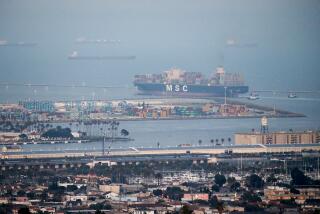China Route Is a Big Bet for Small Shipping Line
- Share via
For 124 years, Matson Navigation Co. has dominated the waters between the West Coast and Hawaii.
Matson has ferried automobiles, pineapples and even people on its way to capturing 60% of the cargo business between the mainland and the islands. Now, one of the last of the U.S. shipping lines is hoping to boost its fortunes in an unusual way -- with a fast boat from China.
Using five fuel-efficient ships that are almost petite by transpacific standards, Matson has launched weekly service from Shanghai to Long Beach that shaves a few days off the usual trip. It’s placing a $365-million bet on the most competitive shipping market on the planet, hoping that speed sells.
The China route represents a significant risk for a company that has thrived on lucrative contracts protected for eight decades by federal law from foreign competition.
“For us, the question has always been this: How does a niche company survive in the land of the giants?” said Matt Cox, Matson’s chief operating officer. “Well, you don’t retreat into greatness. We want to be part of the China business.”
Oakland-based Matson has entered the China trade at what some analysts regard as a difficult time. The industry is flooded with more ships than it needs, and the U.S. economy is showing signs of cooling.
It is competing by using fewer than half its tiny fleet of 12 containerships. And Matson is up against the likes of Danish shipping giant A.P. Moller-Maersk, which has a fleet of 250 ships operating around the world.
“The China business could turn out badly,” Goldman Sachs Group analysts Jonathan B. Habermann and Carey Callaghan wrote in a report to investors on Matson’s plans. “No U.S.-flagged carrier is currently in this ‘retail’ end of the market in China, and the concern is that the business could have a slow gestation period.”
Jason Kremer, an analyst at the San Francisco office of Caris & Co., agreed: “Right now, the pricing on freight is just too competitive.”
Five months after the start of the China service, there are some positive signs. Matson, a subsidiary of Honolulu-based Alexander & Baldwin Inc., has signed 138 customers and during the second quarter moved 7,500 containers -- both ahead of projections, the company said.
But Matson was hurt by lower-than-expected freight rates and high fuel costs. Those pressures, plus the operation’s start-up costs, cut second-quarter operating income from ocean transportation to $24.4 million from $38.7 million a year earlier.
Difficulties were anticipated, Matson’s Cox said, adding that its trade route has unique strengths.
Matson’s ships make a 35-day round-trip voyage. After departing from Long Beach, they stop in Hawaii and Guam before heading to two Chinese cities -- Ningbo and Shanghai -- and then return directly to Long Beach. Although other carriers send their ships to China carrying a substantial number of empty containers, Cox said, Matson’s are full, at least for the leg to Hawaii.
“Our tolerance for low freight rates is probably higher than those who rely on that China-to-the-West Coast leg for their entire profit,” Cox said.
The company’s ships are less than a third the size of the behemoths favored by international shipping lines for their cost-effective ability to carry 8,000 to 9,000 20-foot-equivalent containers in a single trip. But that makes Matson’s vessels more nimble, completing the Shanghai-to-Long Beach leg in 11 days, which beats the other lines by one to three days, Matson said.
On top of that, customers can gain an extra day or two because Matson’s Long Beach terminal is slightly inland from Terminal Island, which avoids the long delays that port truckers often face in picking up merchandise, the company says. In addition, importers don’t have to pay the extra fees charged by port terminals for containers picked up during peak weekday hours.
“We can [unload] the entire ship when it arrives on Sunday night, have the containers put on wheeled chassis and taken to our off-port facility,” said Ron Forest, Matson’s senior vice president for operations. “Customers can come and pick it up, and it’s already on wheels and they won’t even have to enter the port.”
Some experts believe that Matson will find a number of interested importers.
“If you’re a customer with a goal of obtaining frequent, small deliveries, where the offloading and uploading is quick, it makes eminent good sense,” said Simon Croom, executive director of the Supply Chain Management Institute at the University of San Diego.
Crystal Art Gallery of Vernon is one of them.
Weary of dealing with multiple shipping lines for the roughly 1,000 containers of artwork and mirrors the company imports a year, management looked at several carriers to find one that they could give most of their business to, said Jim Ehren, Crystal Art Gallery’s chief financial officer. The company selected Matson.
“Included in their service was bringing [the merchandise] right to our doors. We don’t need to find a trucking company. We don’t need drivers. Basically, it was like one-stop shopping,” Ehren said. The containers usually show up in Vernon within 48 hours of the ship’s arrival, he said. “It was great for us.”
The catalyst for the new venture was the end of a moneymaking 10-year arrangement with APL, the former U.S. ocean carrier once called American President Line that is now owned by Neptune Orient Lines of Singapore.
Under the setup that expired in February, Matson leased three ships and container capacity to APL for service to Hawaii, Guam and Asia. APL operated the ships and gave Matson a cut of the revenue.
Matson already had become what Goldman Sachs Group called “one of the most profitable maritime shipping companies” by dominating the lucrative niche cargo route between the U.S. mainland and Hawaii and Guam. A provision of the Merchant Marine Act of 1920 protects that route from foreign competition by requiring that all cargo moving between U.S. ports be carried in U.S.-built ships owned by U.S. companies and operated by U.S. crews.
The loss of the APL contract meant a potential hit of $10 million to $20 million to Matson’s annual operating profit and $35 million to revenue. With the APL contract in place last year, Matson saw operating income rise 18% to $128 million and revenue increase 3% to $878.3 million. That represented about half the revenue and most of the profit posted in 2005 by parent Alexander & Baldwin, which also grows sugar cane and coffee and manages real estate holdings.
Matson had a choice of living off its Hawaii cargo business against a challenge from two smaller U.S. competitors or taking the kind of risk that the company has been known for throughout its history.
Matson traces its origin to 1882, when William Matson sailed a three-masted schooner named Emma Claudina from San Francisco to Hilo, Hawaii, with 300 tons of food, plantation supplies and other cargo.
Matson brought the first high-end hotels and cruise ships to Hawaii in the 1920s, overcame the loss of one-fourth of its vessels in World War II and helped pioneer the use of containerships in the Pacific nearly 50 years ago. In 1969, Alexander & Baldwin, which bought a minority interest in Matson in 1908, purchased the remainder of the shipping line.
In 1970, Matson sold its luxury ocean liners, 11 years after getting out of the hotel business. The company concentrated on shipping freight between Hawaii and West Coast ports; in the 1980s, it formed logistics and container-leasing subsidiaries. Guam was added as a port of call in the 1990s.
Since 2003, Matson has operated out of a nondescript office building in Oakland with only a few reminders of its rich legacy: the nameplate of a former vessel, a few models of current ships and a few paintings that mimic old Matson color ads.
“Our company has a history of great service,” Forest said. “We are going to prove that here” with the new China service.
For Beme International of San Diego, which sells curtain rods to national retailers, an important benefit of switching to Matson was the elimination of the surcharge for picking up cargo during peak hours, said Mark McDonough, Beme’s director of logistics.
“They have been on time, and they have done what they promised,” McDonough said. “So far so good.”
*
More to Read
Inside the business of entertainment
The Wide Shot brings you news, analysis and insights on everything from streaming wars to production — and what it all means for the future.
You may occasionally receive promotional content from the Los Angeles Times.











